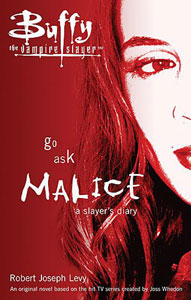It’s probably too strong of a statement to say Robert Joseph Levy’s “Go Ask Malice: A Slayer’s Diary” (June 2006) is the best Faith story. There’s no question it stands on the shoulders of the work done by “Buffy” and “Angel” TV writers and actress Eliza Dushku. But the book allows us to go deeper than ever before into the psyche of Faith, quite a change from the early days of “Buffy” books when the character was totally off limits.
It’s an appropriately scary and messed-up place to be, and I feel it lines up quite well with the Faith we see on the outside – someone who sinks so low as to be the evil Slayer for a while but who ultimately has a good heart. The fact that Faith is a good person at her core after going through the travails accounted in “Go Ask Malice” is pretty impressive, and it makes a reader want to root for her – even though she steals a Gameboy from a kid on one of the final pages.
But first, we have to accept a far-out conceit: that Faith keeps a journal. She’s probably the least likely Buffyverse character to keep a journal, for multiple reasons, one of which is that journals encourage self-reflection, and Faith’s deliberate lack of self-reflection is what allows her to function. Additionally, many of her journal entries are more like a first-person recounting of the day’s events, complete with dialog, like a “Tales of the Slayer” installment. Then again, I maybe shouldn’t question her storytelling ability; she certainly has Xander hanging on her every word in “Faith, Hope & Trick” (3.3).
I went with it, though. I can imagine Faith stops writing in the journal – as mandated by her Boston high school guidance counselor, named V — once she gets to Sunnydale and thinks she finds a clean, clear purpose in her life: slaying vampires. Before that, her troubles are complex enough to warrant writing them down just to make sense of them. Faith is partially possessed by a ghost of some kind and her actions get so wonky that she (rather helpfully) pastes copies of pages from her Watcher’s journal into her own so we can get the full picture.
“Go Ask Malice” takes us through Faith’s formative (or deformative, if you will) years in Boston living as a latchkey kid with her drugged-out mother, surviving in a strict foster home presided over by a religious couple, and crashing at the pads of skeezy boyfriends. These sequences feel familiar from gritty indie movies, but in an illustrative way, and the foster-home portion plays like one of those fun, cheap horror movies, with a vampire in the attic.
Of the three boyfriends she mentions in “Faith, Hope & Trick,” Kenny – the alcoholic drummer for Faith’s favorite band, Freak Wharf — is the most present and important in her life. I’m reminded a bit of the Buffy-Pike relationship in “The Origin” in the way Kenny is in the thick of it with Faith and her Watcher, Diana, in this mystery that eventually leads to Faith’s pivotal first battle with Kakistos (a conflict to be continued in Sunnydale, of course).

When Faith comes under the guardianship of Watcher Diana, whom she calls “the Prof,” “Go Ask Malice” begins to feel like a more traditional Buffyverse story, but the fact that we’re armed with Faith’s backstory makes it richer. The narrative of Faith being partially possessed by a ghost and gathering bizarre clues in her dreams is complex, but I like the way it adds to Faith’s confusion. She’s always struck me as a character who doesn’t totally believe in the righteousness of her own pronouncements (even if it’s as simple as “Want, take, have”), so it fits that she doesn’t know what’s real and what isn’t.
Levy’s attention to continuity – notably incorporating the boyfriends – is pretty good, but there is one awkward portion: Faith reads in Diana’s journal that the Watcher is fretting about the Cruciamentum. This point in the timeline is between Seasons 2 and 3, and since Faith is a year younger than Buffy (whose 18th birthday is mid-Season 3), Faith’s Cruciamentum wouldn’t happen for another year and a half. It seems too early for Diana to be worrying about that, considering their more immediate troubles. I wonder if Levy was under the mistaken impression that Faith is older than Buffy and that her Cruciamentum is coming up soon.
Another notable continuity glitch came about after the book’s publication thanks to the “Angel & Faith” Season 9 comics, where Faith’s father, Patrick Lehane, visits his daughter in London. He’s a troubled small-time criminal, but he was present for a good chunk of Faith’s childhood, rendering most of “Go Ask Malice” apocryphal. Additionally, her father in this book is named George Patrick Lehane, and he’s in prison for life for murder. Faith, who hasn’t seen him since she was 4, briefly visits him in prison and tells him she’s not going to visit again, thus closing that chapter in her life.
The very fact that Faith had a home life – even a not-so-great one – in the official canon softens up her background in comparison to “Go Ask Malice,” and I think Levy’s version is more tragic and appropriate to Faith’s overall path. As with Oz’s off-screen adventures in Season 4, chronicled by Christopher Golden, “Go Ask Malice” is a piece of tie-in fiction I wish the canon had incorporated.
The nice thing is that “Go Ask Malice’s” format allows flexibility. Lying is one of Faith’s traits, as famously illustrated in “Bad Girls” (3.14) and “Consequences” (3.15), so maybe this journal is at times an outlet for her imagination. We can accept as factual the parts that haven’t been contradicted by canon, and read the other parts as Faith’s imagination, although these chronicles can have emotional truths to them. The idea that Faith imagines her father in prison for life, someone she’ll never visit again, could be a coping mechanism for the reality that he’s unreliable and in and out of jail.
But even as a non-canon curiosity in “Buffy” publishing history, “Go Ask Malice” remains a page-turner and easily the best piece of Faith spinoff fiction you’ll find.
Click here for an index of all of John’s “Buffy” and “Angel” reviews.

